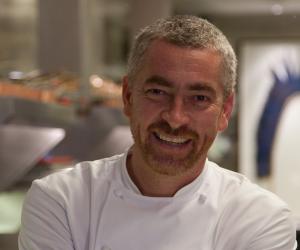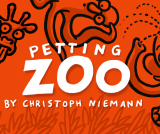Brazilian chef Alex Atala describes his approach to cooking using responsibly sourced Amazonian products at the 2013 Design Indaba conference to render the true essence of Brazilian food.
When Atala, with tightly cropped gray hair, countless tattoos and a graying red beard, opened his São Paulo restaurant D.O.M. in 1999 —now rated the best on the continent and fourth best in the world — he made a decision that was to change the history of modern Brazilian cuisine.
D.O.M. derives from the Latin, Deo Optimo Maximo – God is great and exceeding – good in his wisdom and exceeding in his kindness. Atala wanted to change the way his nation was considered on a plate and believed ingredients like acai, pupunha or cupuacu to be the very essence of Brazil and that their uniqueness should be celebrated.
Having trained in Europe at the Ecole Hôtelière de Namur in Belgium, then in some of finest Michelin restaurants in Italy and France, he realised, without ready access to the supply of quality ingredients he would never be able to truly translate European food on a gastronomic level back in Brazil. However, by using local ingredients, those that capture the flavours, colours, textures and even smells he has been able to create the experience of what it is to eat in Brazil. In essence, Atala applies European techniques to Brazilian ingredients creating anything up to 20 course tasting menus.
"I believe that one of the things that unites us is the will to make a modern, creative cuisine, but always to talk about our origins, our culture and our products," says Alex Atala.
"A good dish comes from a great ingredient: okra for example is an abundant vegetable in brazil. we have at least six ingredients on D.O.M.’s menu with social and environmental benefits that are just as high than the excellent quality of the products, such as the pupunha heart of palm, the priprioca, the manioc products ... all the Amazonian products."
Audacious was his desire to begin developing a haute cuisine based on Brazilian ingredients that had been previously classified as less sophisticated, less important and less interesting - if they were known at all - than the foods from Italy and France that had dominated diners' interests.
His intense lifelong connection to Brazil's massive rainforest — the Amazon is bigger than all of Western Europe — and his ability to navigate its many pitfalls have fundamentally propelled D.O.M.'s success. There are insects on the menu, a vibrant yellow sauce called tucupi must be boiled for 20 minutes to eliminate its lingering natural toxicity. Coconut apple is the spongy mass that grows inside a germinated coconut, and it's not typically consumed; nevertheless, Atala slices it and pairs it with seaweed, giving the dish the flavour, he says, of a beach after a storm — which is exactly what it tastes like.
Developing menus with a strong presence of native ingredients required time and research. Some of that research had been far-reaching into the Amazon rainforest.
Over the years, with the help of the social environmental institute, Atala has worked meticulously with scientists and anthropologists to discover and classify foods and document new products from the Amazon region, with minimum impact on both forest and people.without a doubt, Atala’s unbridled creativity, passion and dogged ambition for Brazilian produce and ingredients, is tempered only by his sensitive, sustainable and intelligent methods in cultivating them.
"Gastronomy can be a tool for sustainability and the conservation of the environment. I mean, if it was easy, everyone would be doing it, but we are living a historical culinary moment, and that’s an important thing. Today, the star chef has not only to learn how to cook and to administrate the restaurant, but also how to talk in public, how to give classes and write books, how to do radio and TV shows... I would hope that the future will bring us a chef becoming more than a cook by gaining the conscience of the social actions."
His ambition now is to promote Brazilian produce on an international scale and hopes that, given time and the development of sustainable farming strategies, acai berries become as normal as pasta or blueberries in store cupboards throughout the world.
His first product "mini arroz", an exclusive variety of rice by grower Francisco Ruzene, has already been launched under the brand "Retratos do Gosto".
One of his tattoos inked across his right arm shows a comic strip - a simple linear equation, that now has also been reproduced on his "Alex Atala t-shirt" that he was wearing when designboom met him. The story goes: a sad face with mohawk a plus sign and a boiling pot, then, there's an equal sign and a happy face wearing a toque.
"I've had two lives," says atala. "I was a punk who became a happy chef."
in his teens, Atala began sporting a red mohawk and crude piercings: needles protruding from his neck, cheeks and ears.
He was both an amateur welterweight boxer and a DJ at the seminal São Paulo club "Rose Bom Bom".
"Problems with drugs and fights," says atala, "we didn't have so much heroin in São Paulo. Cocaine a lot. It was the time when ecstasy first came out."
In 1989 when Atala got clean and moved to Europe he needed a visa to stay on the continent. The easiest route? Admission to a culinary school outside of Brussels. Later he tried to get a job cooking in Paris. While cooking in Belgium and France, Atala worked with chef Bernard Loiseau (who committed suicide after French newspaper Le Figaro suggested he was about to lose a Michelin star.
In 1993 he moved to Milan and found a job at an osteria called Sancho Panza. When Atala returned to Brazil in 1994, he began his career in São Paulo at a restaurant called Sushi Pasta before moving on to two of the most acclaimed Italian eateries of the time. At the end of 1998, Atala opened his own restaurant... after the successful experience with D.O.M. where lunch and dinner are booked months in advance, in January 2009, he opened a second restaurant Dalva e Dito focusing on Brazilian heritage dishes based on home recipes.
Atala is the author of three books, Por Uma Gastronomia Brasileira (Bei Editora, 2003), Com Unhas, Dentes & Cuca (Editora Senac) and Escoffianas Brasileiras (Larrouse Brasil).
Cook it Raw is due to be released by Phaidon in 2013. Cook it Raw tells the story of an exciting collection of avant garde chefs who come together to create unique dining experiences that explore and question social, cultural and environmental issues. Held initially in Copenhagen to mark the 2009 climate change summit the first ‘raw’ dinner challenged the chefs to examine the issue of sustainability.
As the events have developed so too have the issues, themes and general philosophy of the group. Winter and the question of creativity (Collio-Italy), the wilderness and culinary comradeship (Lapland) and tradition and the artisan (Iskikawa-Japan) have all been explored on the plate by Alex Atala and the likes of Rene Redzepi, Albert Adria, Daniel Patterson, Magnus Nilsson, Inaki Aizparte, Massimo Bottura and Claude Bosi.
All photos © designboom.












